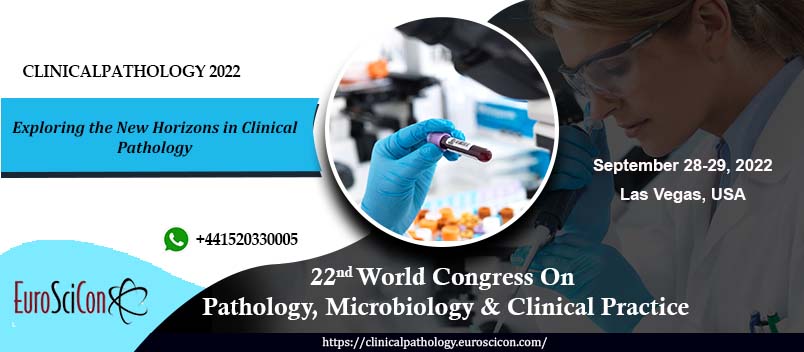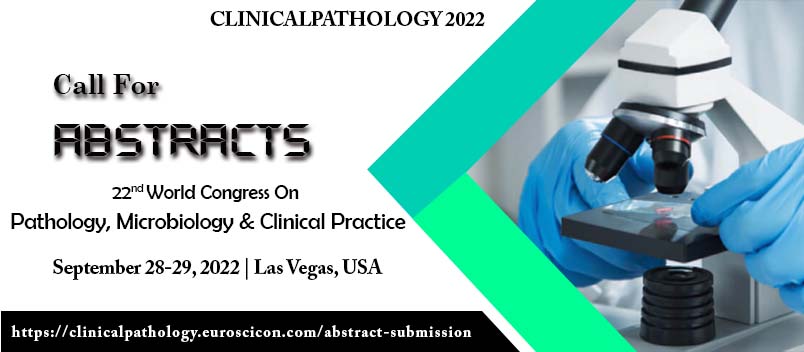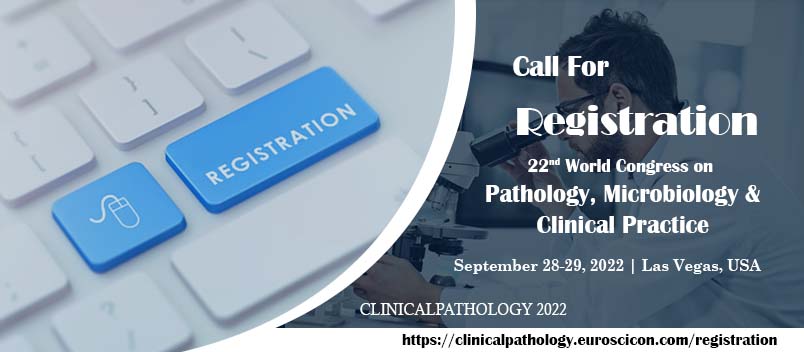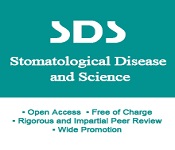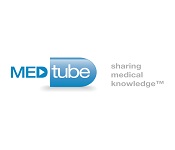CLINICALPATHOLOGY 2022
ABOUT CONFERENCE
ABOUT CONFERENCE
EuroSciCon will be hosting the 2nd International Conference on Infectious Diseases during July 18, 2022 in Barcelona, Spain. The main theme of our conference is “Exploring the Latest Advancements in Pathology against Covid_19" with an objective to inspire young minds and their research abilities by providing an opportunity to meet the professionals in the field of pathology.
Who can attend
- Pathologists
- Oncologists
- Scientists
- Academic Institutes
- Biotechnologists
- Healthcare Professionals
- Researchers
- Pharmaceutical Researcher
- Clinical Organization
- Medical College Doctors and students
- Pharma and Medical Industrialists
- CEO’s and Dean
- Professors and Post Doc Fellows
ABOUT SUBJECT
The word pathology itself might be utilized comprehensively to allude to the investigation of illness when all is said in done, consolidating an extensive variety of bioscience explore fields and medicinal practices. As a field of general request and research, pathology tends to four segments of ailment: cause, instruments of advancement (pathogenesis), basic adjustments of cells (morphologic changes), and the results of changes (clinical manifestations),in like manner medicinal practice, general pathology is for the most part worried about examining known clinical variations from the norm that are markers or antecedents for both irresistible and non-irresistible illness and is led by specialists in one of two noteworthy strengths, anatomical pathology and clinical pathology. Assist divisions in claim to fame exist based on the included example composes (looking at, for instance, cytopathology, hematopathology, and histopathology), organs (as in renal pathology), and physiological frameworks (oral pathology), and based on the focal point of the examination (similarly as with scientific pathology).
What’s New?
Clinical Pathology & Infectious Diseases meeting is to discuss about various new upcoming technologies, future and current developments and lines of research determining the future of Clinical Pathology & Infectious Diseases. Experts from all over world will discuss the pros and cons of all the developments and how the upcoming technologies or procedures will change the face of Pathology, Pathologists, Researchers, Scientists and Lecturers. Also, it is a platform, where everyone can share their ideas and interact with global experts to expand their knowledge in the arena of Clinical Pathology & Infectious Diseases and to build new contacts creating collaborative research opportunities in the sector of Pathology and related disciplines.
SESSIONS AND TRACKS
Track 1: Pathology
Pathology may be a subspecialty within the field of drugs which deals with the study of diseases. The word Pathology derives its origin from the Greek words “Pathos” meaning “disease” and “Logos” meaning “study”. A pathological condition is that the one that's caused by a disease, instead of occurring physiologically. Pathology includes the cause, epidemiology, pathogenesis, morphogenesis, and manifestations of the disease the main role of a pathologist is the prognosis, diagnosis, treatment of the disease and patient care using novel techniques. There are four main types of disease: infectious diseases, deficiency diseases, genetic diseases (hereditary and non-hereditary), and physiological diseases. Pathology is a vast field and there are many branches such as Anatomical Pathology, Clinical Pathology, Psycho Pathology, Molecular Pathology and many more. Advancements in techniques used in the Pathological treatment of diseases are rapidly increasing and this field has a vast scope for development.
Track 2: Clinical pathology
Clinical pathology deals with the diagnosis of disease using the laboratory testing of tissues, blood, bodily fluids etc. It also involves the microscopic evaluation of individual cells. Clinical pathology includes clinical chemistry and biology, toxicology, blood bank, immunology and serology etc. Many areas of clinical pathology overlap with the anatomical pathology. This overlap leads to increase in the molecular diagnostics and proteomics.
Track 3: Molecular Pathology
Molecular pathology
Track 4: Medical Microbiology
Medical Microbiology can be defined as the branch of applied microbiology that deals with the study of the microorganisms which cause infectious diseases. It includes diagnosis, prevention and treatment of infectious diseases. Microorganisms plays a vital role in the field of biotechnology and its industrial applications. Recent research has increased in the field of diagnostic microbiology which is used for the diagnosis of infectious diseases. Medical microbiology also involves the study of beneficial microbes which is helpful in combating infectious diseases and promoting health.
A case report may be a detailed report of the side effects, signs, determination, treatment and follow-up of a private patient. Pathology Case reports may contain a statistic profile of the patient, however as a rule portrays an uncommon or novel event. Some case reports likewise contain a literature review of other recorded cases.
Track 6: Forensic Pathology
Forensic pathology is that the study of pathology which cares with the investigation of deaths when there are medico-legal implications. Forensic pathologists generally perform autopsies. forensic medicine helps in evaluating the crime scene evidence including the witness statements. By performing an autopsy, it helps the forensic pathologists to uncover evidence of the injury or diseases.
Track 7: Clinical Chemistry Laboratory
Clinical Chemistry may be a sub-field in Laboratory Medicine which deals with the analysis of body fluids for diagnostic and analytical purposes. Clinical diagnostic tests help to assess a person’s overall health. Clinical Pathology involves testing blood and body fluids, and examination of individual cells and tissues at the microscopic level to diagnose a disease. Diagnostic Bio-markers are wont to detect them and identify the manifestation of a disease and also help in diagnosis, drug target identification and response. There are several disease and drug-related bio-markers available. the standard and safety of medicine and laboratory medicines should be monitored for minimal side effects and effective treatment during the course of drug therapy. A flow cytometer is employed to detect the presence of cancerous cells within the body by analyzing the bone marrow cells or blood cells and determining the WBC count. Clinical lab techniques convince be a necessity for understanding the pathological condition of a disease in patients.
Immunopathology are often defined generally because the branch of drugs that deals with the immune reaction which is related to the diseases. It also can be defined because the study of the pathology of varied sorts of organisms, organ systems and diseases with reference to the immune reaction and immunity. Scientists during this field bring vast development like vaccines, antibodies, therapeutics, and diagnostics.
Chemical pathology is the study and investigation of the biochemical bodily fluids such as blood, urine and cerebrospinal fluids. By understanding how and where the body’s chemistry or process has changed one can understand the cause of disease and it can be easily diagnosed and monitored. Chemical pathology is one of the best fields which bring together science and medicine.
Cytopathology is employed to assist within the diagnosis of cancer, additionally helps within the analysis of certain infectious diseases and other provocative conditions. Cancer Cytopathology is utilized on tests of free cells or tissue parts, instead of histopathology, which concentrates entire tissues. Cytopathology tests are a number of the time called smear tests on the grounds that the specimens could be covers a glass magnifying lens slide for ensuing recoloring and infinitesimal examination. In any case, cytology tests could be found out in several ways, including cytocentrifugation. Diverse kinds of smear tests may likewise be utilized for tumor determination. During this sense, it's named a cytological smear.
Histopathology, the minute investigation of natural tissues influenced by infection, can be exceptionally helpful in making a solution and in deciding the seriousness of debilitated tissues and cells and prognosis of a condition. It is used for the distinguishing proof of various effects of ailments on body tissues and perceives tumor. Histopathology units are found in many healing facilities and there are likewise autonomous private research centers.
The renal pathology research findings are associated with light microscopy, electron microscopy, and immunofluorescence to obtain the accurate diagnosis. Renal Pathology or kidney pathology covers the topics toxic tubular necrosis, renal carcinomas, Diabetic glomerulosclerosis and other kidney related diseases examined under a microscope or molecular testing. Renal pathology in nephrology, toxins, tumors and Pathology of lupus glomerulonephritis are also very important to research topics for renal pathology. Medical renal diseases may affect the glomerulus, the tubules, and interstitium, the vessels, or a combination of these compartments.
Dermatopathology may be a combination of dermatology and pathology which specialise in the study of cutaneous disease at the microscopic and molecular level. Sometimes dermatologists got to do skin biopsy which is examined under the microscope to seek out out precisely the explanation for disease. Biopsies also need specialized testing like immunofluorescence, immunohistochemistry, microscope , flow chemistry and molecular pathogenic analysis. Dermatopathology cases may sometimes include melanoma, and other skin disorders, infectious and pediatric diseases.
Veterinary pathologists are specialists of veterinary solution who invest huge energy in the determination of ailments through the examination of animal tissue and body fluids. Other than the finding of the sicknesses in sustenance making animals, accomplice animals, zoo animals and common life, veterinary pathologists furthermore have a basic part in cure exposure and prosperity and sensible research.
Microbial pathology-the investigation of the sub-atomic instruments utilized by organisms to cause infection in people and creatures. Bacterial, protozoan, vegetation and irresistible specialist pathogens have developed a decent type of instruments to determine themselves inside the host and pick up supplements that conjointly cause mischief and infection. Microbial Pathogenesis is the investigation of the atomic systems utilized by microorganisms to cause ailment in people and creatures. Bacterial, protozoan, parasitic and viral pathogens have developed a wide assortment of instruments to build up themselves in the host and pick up supplements, which likewise cause harm and malady. Different systems of pathogenesis incorporate host guard avoidance.
Track 16: Oncopathology
Oncopathology is a branch of Cytopathology which is identified with oncology. The branch of medication that arrangements with the revolution, assurance, and treatment of malignancy are oncology. Changes in the association of ailment are extremely essential so on pathologists should be invigorated about the latest progression. The oncopathologist are stressed over the etiology and course of human threat and its assurance and avoidance. The goal of Cancer Cytopathology is to give a discourse to the exchanging of information among oncopathologists.
Bacteria are single cellular microorganisms that lack a nuclear membrane and are dividing by binary fission. The study of bacteria called as bacteriology. Bacteriological study helps in the field of agricultural, or soil, bacteriology; clinical diagnostic bacteriology; industrial bacteriology; marine bacteriology; public-health bacteriology; sanitary, or hygienic, bacteriology; and systematic bacteriology. Major researches in this field help in development of many useful vaccines. The major advantages are the discovery of antibiotics that are helpful in the diagnosis of various types of disease. Recombinant bacteria are useful in bacteriologic research to manufacture biomolecules (e.g. interferon) needed for research and patient care.
Virology is the study of viruses, about the nucleic acid and protein that are responsible for their replication in plants, animals and humans. It reveal about the study of their distribution, biochemistry, about their histology, ecology and clinical aspects of virus. It is the scientific discipline concerned with the viruses, physiology, molecular biology and viral diseases along with their causal agents. Cells effected by viruses and the changes in its in response to the virus lead to the manifestations of viral disease.
Clinical aspects or analysis of bacterial diseases and Clinical bacteriology supports the diagnosis of diseases by different types of clinical methods. There are different types of specimens that are used in cases report in clinical pathology. They are blood, urine, sputum, faeces, and other body fluids, which deals with the health care, especially the diagnosis and treatment of different types of disorders in our body.
Track 20: Pathogenesis
Pathogenesis is the term used to describe the origin and development of a disease. It is determined by the balance between host and virus. The pathogenesis of infectious diseases describes the mechanisms of its development, progression, and either persists or is resolved. To understand the pathogenesis of an infectious disease at the cellular and molecular levels is difficult for discovering, developing, and implementing methods to prevent infection, and to improve patient outcomes after treatment.
Digital Pathology and e-Pathology e-Pathology is defining the new paradigm of anatomic pathology. Telepathology image-based information sent to the far distance by telecommunication technology for research analysis in both academic and business side. e-Pathology may be a complete scan of a microscopic glass slide and therefore the viewing of the eSlide on a computer monitor through a digital software . The researchers in pathology look beyond the Advancements in diagnosis pathology by using the automated image analysis. the worldwide digital pathology market, valued at $1.98 billion in 2012, is estimated to succeed in $5.7 billion by 2020. The Association of Digital Pathology is that the main Association in Digital pathology field and conducts annual Pathology meetings. Ventana, Leica, Philips, GE Healthcare are the most competitors for Digital Pathology software updates and new releases.
MARKET ANALYSIS
Pathology is the causal study of diseases by examining the sample of body tissues (for example, Pap smears / biopsies) and body fluids (for example, blood / urine, etc.). It creates a bridge between health science and medicine. Pathology covers all aspects of patient care, from diagnosis to treatment and prevention advice. In general, pathologists work with doctors, scientists, nurses and healthcare professionals in hospitals and GP surgeries to diagnose, prevent and treat diseases. All segments of pathology are composed of more than 20 different disciplines, starting with general disciplines such as cytopathology, histopathology, chemical pathology, hematopathology, anatomical pathology, medical microbiology and more advanced digital pathology.
The global market for Clinical Pathology generated approximately US $ 1.98 billion in 2012 and is expected to reach US $ 5.7 billion by 2020. The automation of conventional pathology methods is the main driving force for this market, which leads to improvements in workflow efficiency, analysis efficiency. The other determining factor includes speed and precision in the results, availability of diagnostic resources in remote areas, cost reduction, reduction of procedural costs from the delivery of the slide to the data. The main disadvantage is the strict regulatory approval process for digital pathology systems. The other limiting factors are: cost of integrating the digital pathology system and standardization of technology and data interpretation format between countries. The Whole slide imaging (WSI) is the most revenue generating segment in this arena with the greatest growth potential.
The European Clinical pathology market is estimated to reach $ 151 million in 2021, against $ 62.3 million in 2012. During the same period, the US digital pathology market will reach $ 205.67 million 77.23 million to a 17% CAGR. Among all countries, North America will dominate the Digital Pathology market, followed by Europe, Latin America and Asia-Pacific. Asia-Pacific will witness the fastest growth (at a 13.4% CAGR) during the forecast period. The growth will be supported by an increase in the number of cancer patients, an increase in demand for new patient care facilities and a reduction in laboratory expenses.
Clinical Pathology plays a fundamental role for the study, diagnosis and treatment of several chronic diseases, such as infectious diseases and cancer. Includes analysis of biopsy or body parts to diagnose a disease. It is also very important in the Pharmaceutical Industries to carry out toxicological studies. This clinical pathology market has enormous growth potential, fueled by the increase in the prevalence of chronic diseases, an increase in the aging of the population and, in addition, an increase in health spending worldwide. The global clinical pathology market can be segmented into types of products and services. The pathology services market can be segmented into reagents, consumables, instruments and services. The instruments can be segmented into slide filters, tissue processors, microtomes and the application market can be segmented for drug discovery and diagnosis. The products in terms of users' ca are segmented in diagnostic laboratories, hospitals and research organizations.
The clinical pathology market is dominated by North America, followed by Europe and Asia. This growth is attributed to the rapid increase in the prevalence of chronic diseases, the increase in the aging population, the growing demand for personalized medicine, the presence of a large market and huge government and private investments. The clinical pathology market was valued at around US $ 16.2 billion in
With more than 33 organizations donating computerized pathology equipment, programming pathology and administrations, the global showcase for advanced pathology is estimated to reach about $ 4.5 billion in 2018. The clinical pathology market is expected to bring in $ 1,052 million in 2022. Clinical pathology is on the rise and advancement in the field of pathology. The digitalization of pathology has prompted the computerization of exams in the middle of the investigation, saving costs and attempts. The net effect was an incredible cost reduction across the cost of characteristic methodologies and organizations.
LEARN MORE
Top USA Pathology Universities:
University of Iowa| Purdue University West Lafayette| Northwestern University| University of Wisconsin Madison | University of Arizona | Boston University | Indiana University | University of Texas Austin | Ohio State University | University of Texas Dallas | University of Illinois Urbana Champaign | University of Kansas | MGH Institute of Health Professions | Syracuse University | University of Tennessee Knoxville | University of North Carolina Chapel Hill | Emerson College | University of Connecticut | University of Wisconsin Madison | University of Marylan College Park | Temple University | Pennsylvania State University University Park | University of Colorado Boulder | Purdue University West Lafayette | Rush University Medical Center | University of Nebraska Lincoln | Florida State University | James Madison University | University of Georgia | University of Vermont | University of Utah | University of South Carolina | George Washington University | Arizona State University | University of Massachusetts Amherst | University at Buffalo | Columbia University | University of North Carolina Greensboro | University of Memphis | Teachers College | Northeastern University | San Diego State University | University of Florida | University of Minnesota Twin Cities | University of Pittsburgh | Northwestern University | MGH Institute of Health Professions | University of Washington | Vanderbilt University | University of Cincinnati | University of Oklahoma Health Sciences Center | Ohio University | University of Kentucky | Michigan State University | Gallaudet University
Best Europe Pathology Universities:
University College Dublin | Technische Universitat Munchen | Universite de Geneve | Cardiff University | University of Stirling | University of Birmingham | Maastricht University | Newcastle University | Queen Mary University of London | University of Copenhagen | University of Westminster | University of Southampton | Ecole Polytechnique Federale de Lausanne | University of Edinburgh | University of Brighton | Imperial College London | University of Glasgow | King’s College London | Dublin Institute of Technology | University of Nottingham | University of Bradford | ETH Zurich (Swiss Federal Institute of Technology) | University of Warwick | University of Bristol | University of Leeds | University of Oxford | Newcastle University | University of Groningen | University of Cambridge | University College London | Harper Adams University | University of Liverpool | Trinity College Dublin | University of Nottingham | Durham University | The University of Manchester | University College Dublin | University of St. Andrews | Manchester Metropolitan University | University of Leicester | University of York | Trinity College Dublin | Universitat Zuric.
Top Asia Pacific and Middle East Pathology Universities:
Jordan University of Science and Technology | Sultan Qaboos University | Zayed University | Al Jazeera University UAE | King Faisal University | British University in Dubai | King Saud bin Abdulaziz University for Health Sciences | Maarefa Medical College | Batterjee Medical College | Al Ain University of Science & Technology | Hashemite University | Ibn Sina National College for Medical Studies | United Arab Emirates University | Al Qaseem University | American University of Ras al Khaimah AURAK | University of Hail | Skyline University College | King Saud University | Hamdan Bin Mohammed Smart University | Tabuk University | Alfaisal University | Abu Dhabi University | University of Jordan | Petroleum Institute Abu Dhabi | Masdar Institute of Science & Technology | Gulf Medical University | Jumeira University | Arabian Gulf University | Imam Muhammad ibn Saud Islamic University | Canadian University of Dubai | University of Sharjah | Gulf Medical University | King Khalid University | Al Falah University | Taibah University | Amity University Dubai | Salman bin abdlaziz university | University of Dubai | Yarmouk University| Alhosn University| Kuwait University | Royal College of Surgeons in Ireland | University of Dammam | Ras al-Khaimah Medical and Health Sciences University | American University in the Emirates | Dubai Medical College | Ajman University of Science & Technology | University of Wollongong in Dubai | Umm al-Qura University | Higher Colleges of Technology | Khalifa University of Science, Technology and Research | Oman Medical College | Manipal University Dubai Campus | King Abdulaziz University | Al-Majmaah University | Mutah University | American University in Dubai | American University of Sharjah | Mohammed bin Rashid University | Al Jouf University | Taif University
Top Asia Pathology Universities:
Nagoya University Kyung Hee University | Korea Advanced Institute of Science and Technology (KAIS
